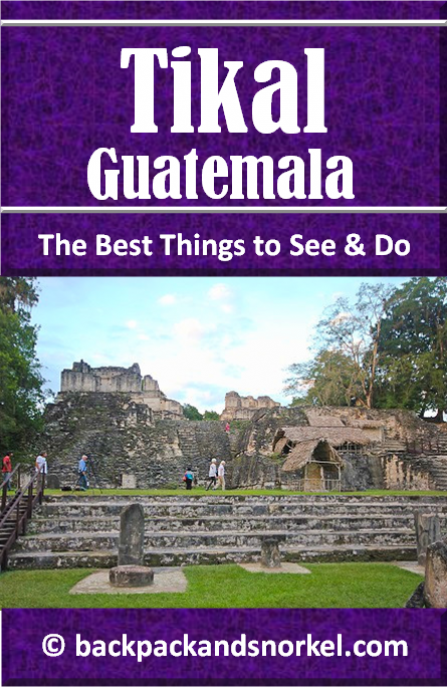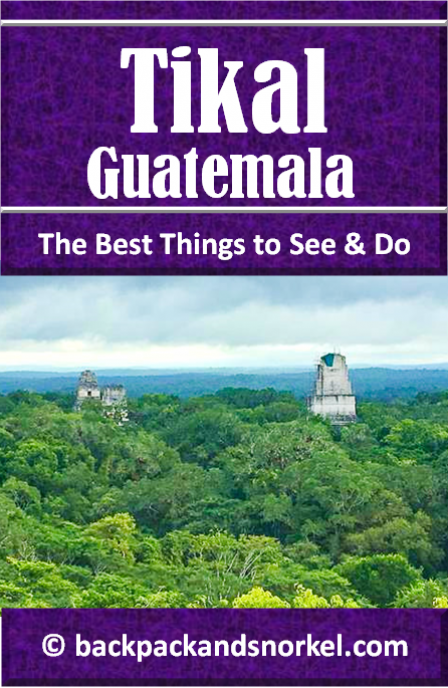LOST WORLD (MUNDO PERDIDO) - Tikal Purple Travel Guide
Covering an area of 650,000 square feet (60,000m2), Mundo Perdido (Lost World) is the largest ancient ceremonial complex in Tikal. We tell you what you can see here and we have lots of background information and photos so you understand what you will see.

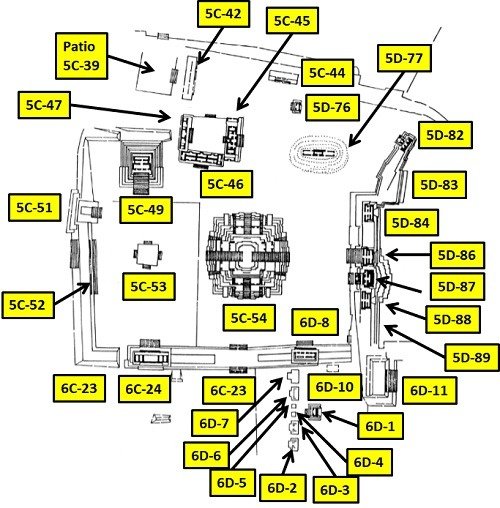
Source: Wolley, Claudia; Roldán, Julio A. , (2003), Rasgos arqueológicos principales dentro de los túneles con acceso abierto de Tikal.
Mundo Perdido was the first architectural complex that was built in Tikal and the last to be abandoned.
It contains 38 structures, and one of them is an astronomical complex (so-called archeological E-Group) consisting of a pyramid aligned with a platform to the east that supported three temples. The main structure is Structure 5C-54 which is called the Great Pyramid of the Lost World.
Mundo Perdido was built in six construction phases and each construction and phase re-envisioned the astronomical complex.
The earliest occupation at this site was before 700BC but it took until approx. 600BC for the first masonry structures to appear.
At around 100AD, three temples were built on the East Platform.
Around 250AD, the Mundo Perdido plaza achieved its current size when it was enlarged it towards the west and the Lost World Pyramid was made the center of the complex.
That was also the time when Tikal’s architectural style was greatly influenced by the great metropolis of Teotihuacan neat today’s Mexico City.
Between 250 and 600AD, Mundo Perdido and the North Acropolis were the two centers of Tikal. And it appears that Mundo Perdido was used as a royal necropolis (burial ground) from 250 to 378AD
At around 700AD, the Temple of the Skulls (Templo de las Calaveras, Structure 5D-87) was built over with a new version which shifted the primary axis of the complex that was associated with the ancient E-Group complex and broke its relationship with the old solar cult which also signaled a major reorganization of Tikal.
Later on, access points to the temple were blocked with new structures and the causeway that linked Mundo Perdido with the North Acropolis was discontinued. In the 7th and 8th centuries, a new palace complex was built in the northern section which shifted the use of the complex from a place dedicated to purely ritual activities to a residential area for Tikal’s elites that was likely involved in the city’s administration.
Three elite status burials were made at Mundo Perdido during the 8th and 9th centuries, underlining the importance of this area during this time.
When Tikal went into a decline before it was finally abandoned, Mundo Perdido arrears to have continued as a center of construction and ceremonial burial activity.
It appears that most activity was concentrated in the northern portion of the site where the Temple Reservoir was. In particular, construction activity at Structures 5C-45, 5C-46 and 5C-47 indicates that Tikal’s elites must have resided here right until the city was abandoned. Strengthening this argument is the quantity of burials during that time.
Even after Tikal was abandoned, it appears that the palace area of Mundo Perdido stayed occupied (including with the elites) for at least another hundred years. Ritual activity at nearby Temple III was also found during that time. It is speculated that this may be linked to the nearby water reservoir.
Structures and burials at Mundo Perdido:
Back to the Self-Guided Walking Tour of Tikal
E-GROUP
The original center of Mundo Perdido was this E-Group astronomical complex.
The east stairway of the Lost World Pyramid (Structure 5C-54) was the observation point and the three original temples on the East Platform (5D-84, 5D-86 and 5D-88) were markers used to plot the sunrise on the equinoxes and the solstices. The E-Group underwent seven distinct construction phases.
Back to Structures and burials at Mundo Perdido.
Back to the Self-Guided Walking Tour of Tikal
LOST WORLD PYRAMID (GREAT PYRAMID, STRUCTURE 5C-54)
This pyramid is the focus of the Mundo Perdido complex. It is 101ft (31m) tall and 236ft (72m) wide which made it one of the most massive structures in Tikal.
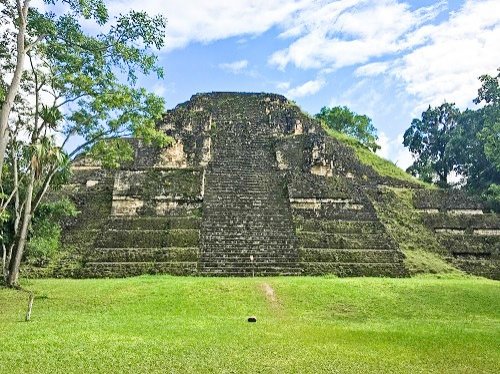
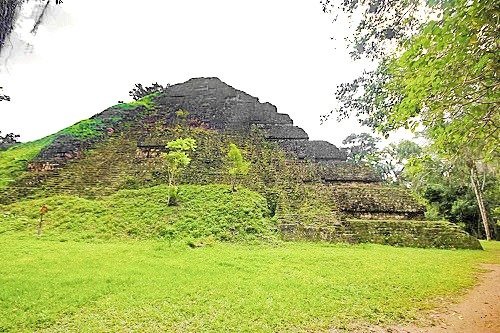
Access of the pyramid is on the west side where there were giant masks, but there are stairways on the east and west sides of the pyramid that extended to the top. Additional stairways on the north and south sides only extend to the eighth of ten levels.
The pyramid that is visible today is the fifth version and was built around 250AD. At that time, it was the tallest structure in Tikal.
Traces of painted stucco indicate that the last version of the pyramid was painted in blue and red at some point in time.
The five construction phases of the Lost World Pyramid each built upon the previous version. They were not built directly centered upon the previous version in order to maintain the E-Group plaza area between the pyramid and the East Platform. To do this, the east façade had to be destroyed and rebuilt every time, while the rest of each previous version was built upon.
Construction phases of the Lost World Pyramid:
Phase |
Date built |
Height |
North-South width |
Stories |
1 |
600BC |
9.6ft (2.9m) |
77ft (23.5m) |
3 |
2 |
500BC |
26ft (7.8m) |
122ft (37.3m) |
4 |
3 |
300BC |
31ft (9.5m) |
123.6ft (37.7m) |
6 |
4 |
1BC |
59ft (18m) |
200ft (60m) |
8+ |
5 |
250AD |
101ft (30.7m) |
236ft (72m) |
10 |
Phase 1
For the construction, the ground was leveled with up to 4.7ft (1.4m) deep infill . Not much of the original pyramid has survived. It is believed that it had three stepped levels with stairways on all four sides.
Phase 2
This version of the pyramid had four stepped levels and more than doubled the height of the previous pyramid.
Phase 3
This version had six stepped levels and a raised upper platform with rounded corners.
The fifth level had giant masks that flanked the central stairways which ascended the sixth level.
The construction was of high quality with complex architectural detail and high quality stucco finishes.
Phase 4
The fourth version of the pyramid almost doubled the height and width of the pyramid. This temple had at least eight stepped levels. The exact number could not be determined as the next construction phase did a great deal of damage to this version. Giant masks were found on the fifth stepped level.
From an architectural standpoint, this version of the pyramid was weak due to unfavorable with distribution and periodic reinforcement was needed. The specific architectural style was never used in Tikal again indicating that the architects realized what their mistakes were.
Phase 5
This final version of the pyramid had ten levels and judging by the surface area it occupies, it was the most massive construction project at Tikal.
When excavated, the fifth and last version of the pyramid was found to be in bad shape with its sides subsided in many places. This was due to poor quality of the structural infill that was used in its construction.
It is important to note that Phase 5 was not a continuous construction phase. The pyramid started with 8 levels between 200 and 300AD, the ninth level was added in the 4th century and the tenth level sometime between the late 4th and the early 6th century.
Back to the Self-Guided Walking Tour of Tikal
EAST PLATFORM (STRUCTURES 5D-82 THROUGH 5D-89)
The East Platform divides the Mundo Perdido complex from the Plaza of the Seven Temples.
It is one of the earliest examples of architecture in Tikal, but it only got its final shape in 100AD when the first versions of the three Structures 5D-84, 5D-86 and 5D-88 were built.
Structure 5D-82
The first version of this structure was a building with a single room on a semicircular platform that was built in the 4th century AD. It was decorated with an elaborate stucco frieze that was decorated with figures and hieroglyphs. Architects believe the central figure represents the deity Itzamna.
Structure 5D-84
This structure was one of the first three temples that were built on the East Platform. It had three rooms.
Structure 5D-85
This structure is a double platform that provides access to the Plaza of the Seven Temples.
Structure 5D-86
The first version of this temple was built at around 100AD.
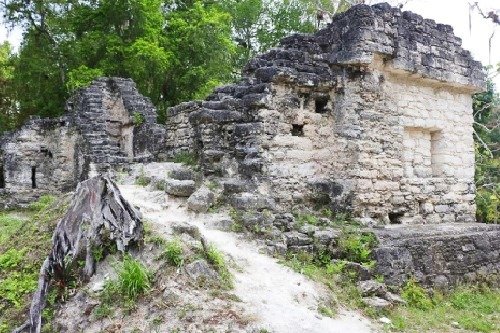
It had three rooms, arranged one behind the other, with the central room being the smallest. Notable are two giant masks on either side of the door of the central room, as this is the only known example of this era where such masks were placed inside a building. More than 100 years later this had become common practice, however.
It is believed that the masks represent Nu B'alam Chac, a spirit protector of the city that was closely associated with warfare. Mundo Perdido’s first royal tomb was installed here.
TEMPLE OF THE SKULLS (TEMPLO DE LAS CALAVERAS, STRUCTURE 5D-87)
This is the third largest temple in the Mundo Perdido complex.
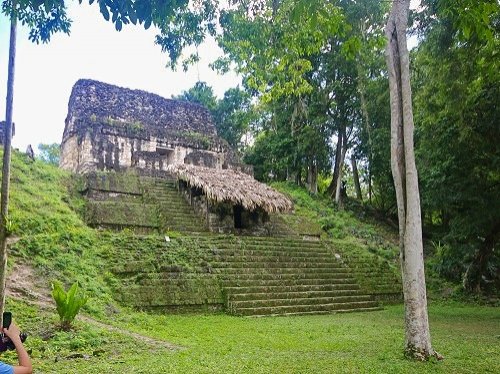
It is notable that each new version of the temple moved its center further away from Mundo Perdido towards the Plaza of the Seven Temples. The version that was built in the 7th century shifted the primary axis of the Mundo Perdido complex, that was associated with the ancient E-Group complex, a lot and thus broke its relationship with the old solar cult which also signaled a major reorganization of Tikal.
The temple has a single room with five doorways that faced the Plaza of the Seven Temples.
Around 700AD, this version was sealed and the last version was built on top of it. It had a four-level platform with an access stairway that was interrupted by a vaulted niche with three sculpted skulls, the center skull one facing forward and the other two to the sides.
Structure 5D-88
This structure was one of the first three temples that were built on the East Platform. It had three rooms.
Structure 5D-89
This structure had three rooms.
Back to the Self-Guided Walking Tour of Tikal
TALUD-TABLERO TEMPLE (STRUCTURE 5C-49)
This temple is the second largest building in Mundo Perdido.
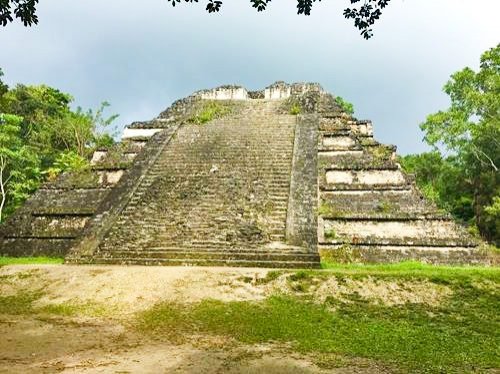
This pyramid has a stairway that goes up to the summit shrine which used to have three rooms and a roof comb. The ceilings and roof comb collapsed into the first two chambers before excavation began.
The pyramid was built in five construction phases.
Phase 1
The first version was built in the late 3rd century AD in a precursor of the talud-tablero style and had three levels. This version was 23ft (7m) tall and the sides were 69ft (21m) at the base.Phase 2
In the 4th century, the pyramid was enlarged. There was no masonry building built on the top.
The surface area at the base was expanded to 9,900 square feet (920m2) and the pyramid had four stepped levels.
The expansion was done in a local variation of the talud-tablero style.Phase 3
The pyramid was enlarged again sometime between 3300 and 550AD. There was still no masonry building built on the top.
The surface area at the base was expanded to 11,460 square feet (1,065m2) and the pyramid now had five stepped levels. The construction was again done in the local talud-tablero variant.Phase 4
The pyramid was enlarged again sometime between 3300 and 550AD. There was still no masonry building built on the top.
The surface area at the base was expanded to 13,300 square feet (1,240m2) and the pyramid went back to four stepped levels.Phase 5
This phase was done between 550 and 700AD and comprised the construction of a new stairway on top of the Phase 4 version of the pyramid.
The pyramid base was slightly expanded to 121 ft (37m) on each side, the stairway widened and the pyramid’s height was heightened by 15ft (4.6m) by the addition of two talud-tablero-style levels.
At this time, the height of the pyramid was 54ft (16.4m). A new masonry summit shrine was built on top with three vaulted rooms and an elaborate roof comb, which collapsed before the temple was excavated.
Back to the Self-Guided Walking Tour of Tikal
PALACE (STRUCTURES 5C-45, 5C-46, AND 5C-47)
This palace complex was built in the 7th and 8th centuries AD and consists of Structure 5C-47 in the west, 5C-46 in the south and 5C-45 in the east. All three buildings were connected at the edges forming a “U” shaped palace. Each of the building had doorways facing the 6,500 square feet (600m2) central courtyard that was open to the north.
The palace was the only part of the Mundo Perdido complex that was used as a residence, the rest was used for ceremonial purposes.
Shortly before Tikal was abandoned, the palace was remodeled and some doorways were closed and new sections with multiple doorways were built.
MISC STRUCTURES (5C-53, 5C-51, 5C-52, 5C-53, 6C-24)
Structure 5C-53
This structure shows influence from ancient powerhouse Teotihuacan, near Mexico City.
Structure 5C-51
This structure was modelled in the talud-tablero style in the 5th century AD.
Structure 5C-52
This is the western-most structure of Mundo Perdido, was built in the 5th century AD using the talud-tablero style.
Structure 5C-53
This is a low platform west of the Lost World Pyramid which shows that its construction at around 600AD was influenced by Teotihuacan near Mexico City. The platform has stairways on all four sides and it seems that nothing was ever built on it.
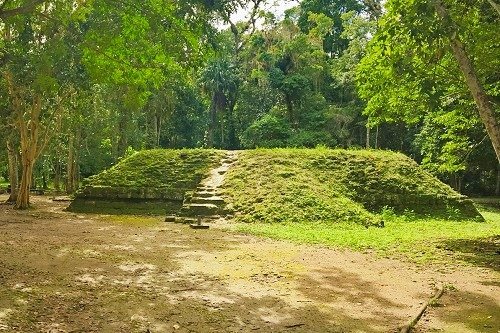
Structure 6C-24
This structure was modelled in the talud-tablero style in the 5th century AD.
Back to the Self-Guided Walking Tour of Tikal
What do you want to explore now?
Author: Rudy at Backpack and Snorkel
Bio: Owner of Backpack and Snorkel Travel Guides. We create in-depth guides to help you plan unforgettable vacations around the world.
Other popular Purple Travel Guides you may be interested in:
Like this Backpack and Snorkel Purple Travel Guide? Pin these for later:

